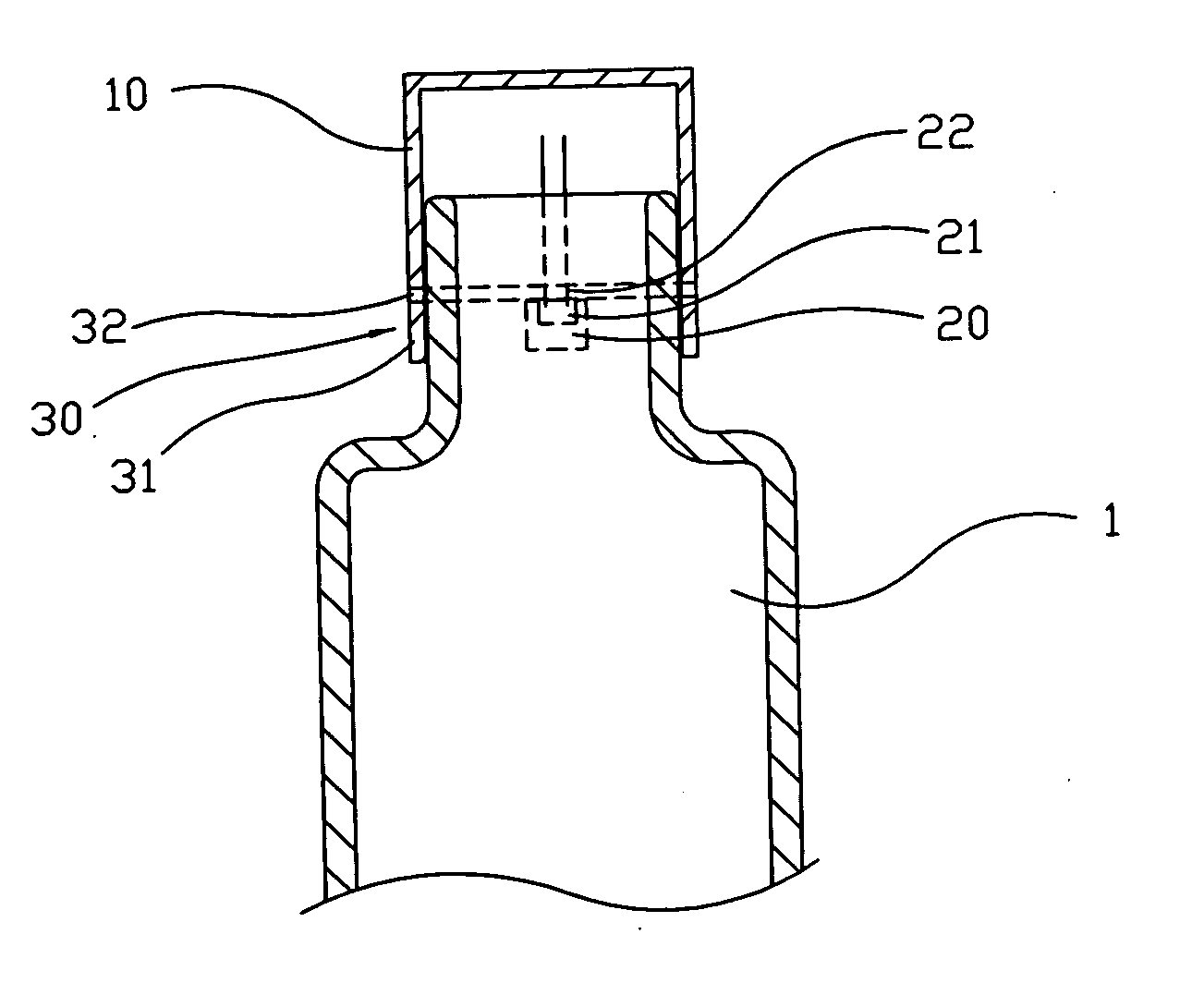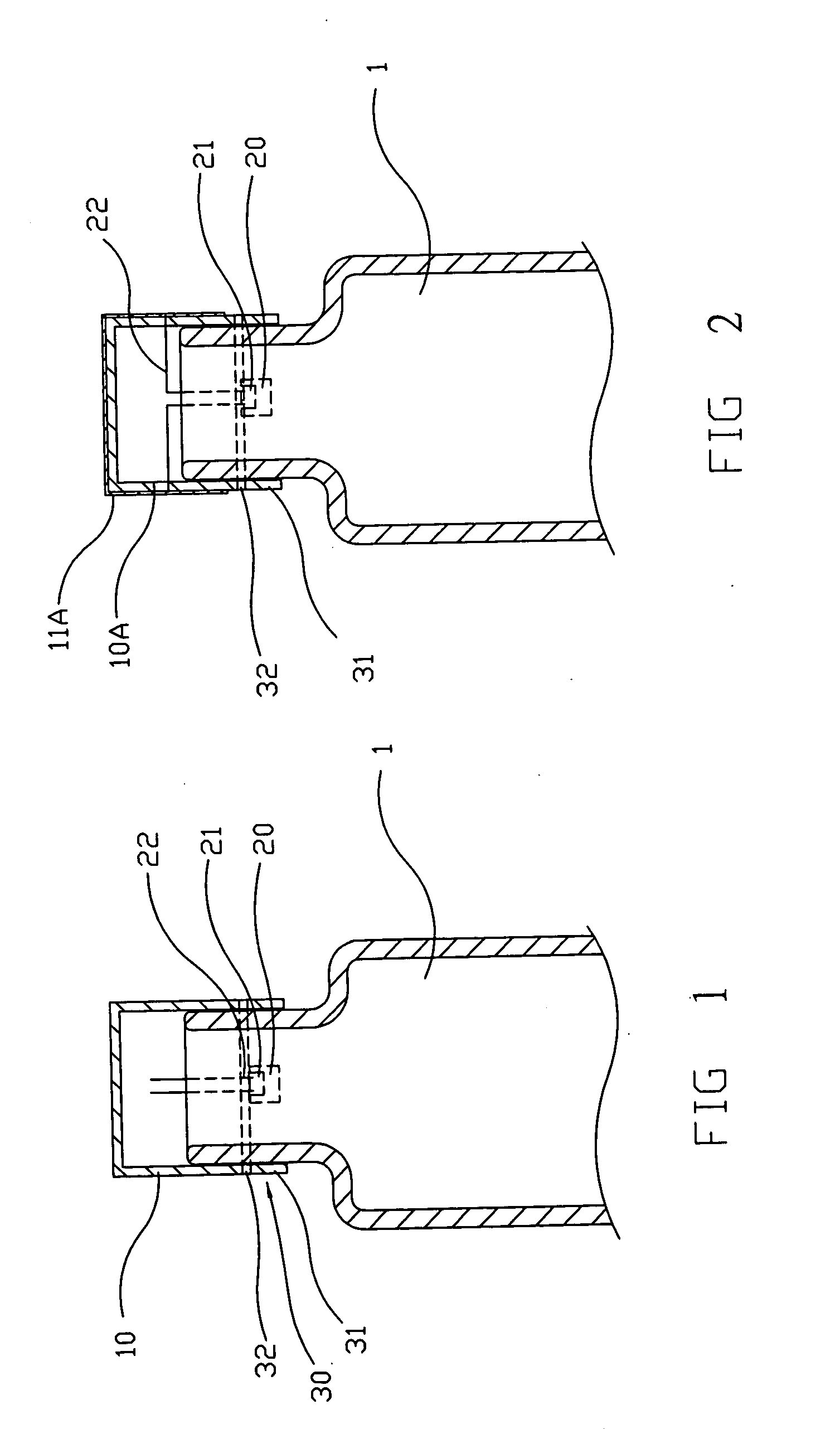Anti-counterfeit sealing cap with identification capability
a technology of anti-counterfeit sealing cap and identification capability, which is applied in the direction of burglar alarm mechanical actuation, protective material radiating elements, instruments, etc., can solve the problems of difficulty in mass production and processing of data, storage space, and easy detection of unauthorized opening and resealing of bottles, so as to increase detection sensitivity, effective measure against counterfeiting, and the effect of large effective area of the antenna
- Summary
- Abstract
- Description
- Claims
- Application Information
AI Technical Summary
Benefits of technology
Problems solved by technology
Method used
Image
Examples
first embodiment
[0015] As shown in FIG. 1, the anti-counterfeit sealing cap with identification capability of the present invention in a first embodiment mainly comprises: a cap body 10, sealing an opening of a container 1 and having a surface; a semiconductor identifying chip 20, attached to an inner side of the cap body 10, storing product data; and a destructing device 30. The identifying chip 20 has a signal emitting device 21. Several connectors 22 connect the signal emitting device 21 and the cap body 10, so that signals generated by the signal emitting device 21 are radiated by the cap body 10 serving as an antenna to a reader in an RFID device for frequency identification. The destructing device 30 is mounted between the cap body 10 and the container 1. Upon opening the cap body 10, the destructing device 30 destroys the capability of the identifying chip20 to send signals, preventing unauthorized opening and reuse of the cap body 10.
[0016] The identifying chip 20 works similarly to convent...
second embodiment
[0021] Referring to FIG. 2, the present invention in a second embodiment has a cap body 10A made of plastics or another electrically non-conductive material. An antenna 11A made of electrically conductive material covers a large part of the cap body 10A. Electrical connection between the signal emitting device 21 of the identifying chip 20 and the antenna 11A is established by the connectors 22. Preferably, the antenna 11A is a metal plate or is printed on the cap body 10A.
[0022] In the first and second embodiments, the present invention has antennas of nearly equal areas, resulting in nearly equal signal effectivities. The second embodiment of the present invention, however, due to the applicability of plastic caps allows for a wider range of applications.
third embodiment
[0023] Furthermore, as shown in FIG. 3, in the present invention, the destructing device 30 has a plug 33 sealing the container 1. After removing the cap body 10, the plug 33 is separated therefrom. At least one part of the identifying chip 20 is connected with the plug 33, while via the connectors 22 being connected with the cap body 10 or the antenna. Therefore, when the cap body 10 is removed, the identifying chip 20 is tom apart or the connectors 22 break, eliminating any signal emission capability.
[0024] Referring to FIG. 4, in a fourth embodiment of the present invention, the destructing device 30 has a plug 34 which is separate from the cap body 10. In contrast to the third embodiment of the present invention, the identifying chip 20 is mounted on the inner side of the cap body 10 and at least one of the connectors 22 is connected with the plug 34. Therefore, when the cap body 10 is opened, the connectors 22 break, and no transmission of signals from the identifying chip 20 t...
PUM
 Login to View More
Login to View More Abstract
Description
Claims
Application Information
 Login to View More
Login to View More - R&D
- Intellectual Property
- Life Sciences
- Materials
- Tech Scout
- Unparalleled Data Quality
- Higher Quality Content
- 60% Fewer Hallucinations
Browse by: Latest US Patents, China's latest patents, Technical Efficacy Thesaurus, Application Domain, Technology Topic, Popular Technical Reports.
© 2025 PatSnap. All rights reserved.Legal|Privacy policy|Modern Slavery Act Transparency Statement|Sitemap|About US| Contact US: help@patsnap.com



